The future of radio: become a trusted guide within a sound-polluted world. The challenge for radio: cure people’s sound allergies and make audiences listen again. How to do it?
Lokalrundfunktage 2012 featured a speech by Julian Treasure of The Sound Agency, and I thought it would be nice to share it here. Part 1 of this article was all about creating an effective brand sound, and this second part highlights how we can cut through increasing clutter and declining attention to help listeners find their way in a crowded media landscape.
“Radio means relationship”
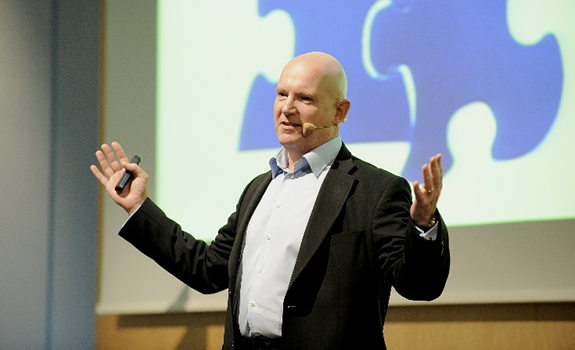
Relatable personalities are radio’s USP, says brand sound consultant Julian Treasure (photo: Lokalrundfunktage)
Reclaim radio’s unique position
Many young people nowadays find their music on YouTube. A video site as a music base, that’s pretty interesting – so is the fact that sound quality apparently doesn’t seem to be crucial for the MP3 generation. “It’s accessible, and it’s free”, Treasure summarizes. In his vision, radio will soon face a democratization of production and distribution of audio, similar to what happened in the print industry. Now that music services like Spotify and Last.fm appropriate the word ‘radio’ more and more, he thinks that it’s time for broadcast radio to reclaim this position.
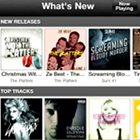 Relate to radio listeners
Relate to radio listeners
Although services like Spotify (photo) are useful tools, Julian Treasure thinks that music streams are not a huge competition for radio in the long term. “Radio means relationship. I’m not interested in algorithmic streams of music that go off track pretty quickly, and I don’t believe that anybody’s ever going to write an algorithm that really understands music. I’m interested in somebody who surprises me.” Radio personalities offer this human factor of emotion.
Leverage radio’s headstart position
Treasure points out that radio is also completely different from the online search experience, where we hop from one piece of content to another that we think we’re going to like. In his opinion, radio has 4 massive assets compared to the typical non-stop music service:
- Brand: radio broadcasters are established brands in their survey area
- Personalities: on-air personalities connect radio listeners and brands together
- Relationships: radio stations build long-term relationships with the audience
- Audience: radio brands therefore have a large community of listeners
“We have a world of noise”
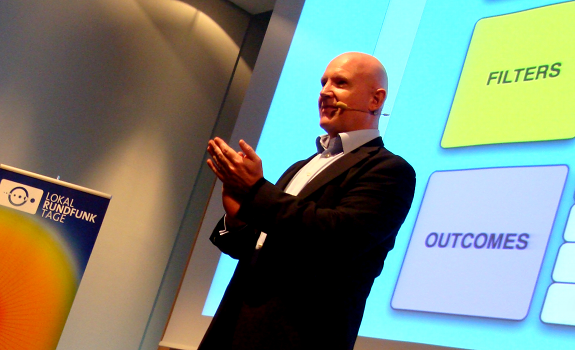
Julian Treasure explains how people use specific filters to differentiate messages from noise (photo: Thomas Giger)
Keep audience communication clutter-free
Despite radio’s benefits, the medium faces a challenge. Julian Treasure quotes Hemingway, who said that most people never listen: “That is increasingly true”. Audiences have been exposed to 400% more brand messages between 1971 and 1997 (from 560 to 3.000 every single day) – imagine how it is now. “We have a world of noise. It’s quite frightening what’s going on. It will form the context for radio, TV and other media to operate in.” I think that what Treasure says, shows the importance of sticking to the essence; of keeping your message clear.
 Remove disturbing background noise
Remove disturbing background noise
It’s evident that a lot of noise can be harmful and exhaust people. The World Health Organization and EU have found that in Europe:
150 million Europeans suffer from sleep deprivation through noise pollution
1 million years of healthy life is lost per year because of this problem
Tens of billions of Euros is the annual cost as a result of this
Give audience tune-in reasons
That we need to give audiences good reasons for listening to our radio station, becomes clear when we see how society trains people to stop paying attention more and more. Julian Treasure mentions 4 reasons why many people stop listening. I’ll summarize them in my own words, unless quoted literally:
1. More content, less consumption
The more we have, the less we use. Audiences switch channels very often, and consume a little bit of everything – even different things simultaneously. They know they can find whatever they need whenever they want. “We don’t have to pay attention so much and we become impatient. We do not want long speeches these days; we want the 3-second sound bite.”
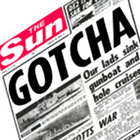 2. Increased shouting, decreased attention
2. Increased shouting, decreased attention
Media are desensitizing us. Media constantly push the boundaries, like tabloid newspapers do with often exaggerating headlines to make the news seem more sensational than it really is and thus sell more of it. “Nobody is just upset, it’s always fury.” It’s the same in advertising. Developments like these cause people to shut their eyes and close their ears more and more for messages from the outside, especially over-the-top promotion.
3. More connection, less communication
The more we are connected, the less we talk personally. Some people break up relationships by sending them a text message like: ‘U R dumped’ which is anything but a conversation. The same goes for “personal broadcasting” through social media. But many status updates are actually not social, but one-way traffic instead: “I’m doing this – it’s not listening, is it? It’s broadcasting.”
 4. More invasion, more defense
4. More invasion, more defense
We are closing ourselves for external communication. Many people wear headphones when they’re outside, which is an interesting and trending social behavior. “People use these to take control of their personal space and to stop being invaded.” Apart from this (anti-) social aspect, there’s an increase of physical hearing loss. It’s been said that 1 in 8 American teens is already affected. “We could raise a whole deaf generation.”
Practice effective listening techniques
Listening is most-used form of human communication: 60% of the time we listen and not write, read or speak. But listening is not really ‘listening’ because humans only retain 1 in 4 words. Assuming this is true, it means that 75% of a spoken message gets lost. Luckily, says Treasure, we can train our auditory skills through practical effort. He mentions 3 ways to distinct signals from noise that humans often use:
- Pattern recognition: we listen up if somebody says our name, even in a large room full of talking people, because it’s a recognizable sound pattern
- Sound differentiation: we block a constantly present and constant form of noise by simply forgetting it’s there after hearing it for a couple of minutes
- Noise filtering: we use many filters that can even change our reality, from culture and language to beliefs, values, attitudes, expectations and intentions
“There are a lot of sounds around you that can be amazing”
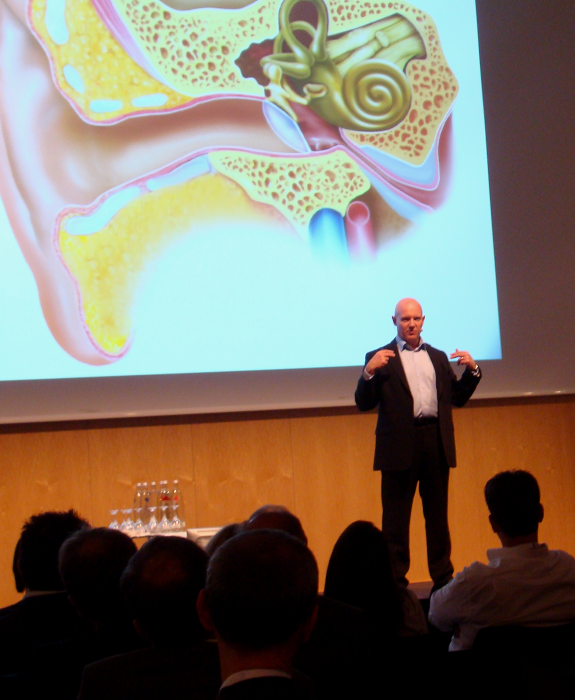
Julian Treasure stimulates radio professionals to practice listening through auditive training (photo: Thomas Giger)
Stretch your hearing sensibilities
A question for radio people is: how can we listen better – and help our audience doing the same? Julian Treasure offers inspiration with 5 ways for better listening and expects that “it could transform they way you relate to the world around you”. Indeed, hos excercises could be good if you’re working with audio every day, like when you’re a radio personality, imaging producer or audio engineer, but also if you’re a music director, program director or brand manager.
1. Reset ears through silence
It is good to experience complete silence for just a few minutes a day. “It recalibrates your ears, resets you, and lets you hear things fresh. If you can’t get absolute silence, just a little bit of quiet will do.”
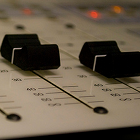 2. Separate individual sound sources
2. Separate individual sound sources
If you hear a noise that seems to consist of multiple sources, ask yourself how many ‘channels of sound’ there are, and mentally identify every sound. You can do this ‘mixer’ exercise in both a loud and a serene place.
3. Find layered sound patterns
Savoring is when we “unhook hidden choirs” in sounds around us. “My tumble dryer at home makes a noise that I discovered was a waltz” (because of its typical 3/4 rhythm). “There are a lot of sounds around you that, if you listen to them, can be amazing.”
 4. Listen from different perspectives
4. Listen from different perspectives
An important skill is to choose alternate approaches. “Imagine there’s a house on a hill, and you’re looking at it from a place. You can get up on the other side and see how it looks from there.” There are 3 ways to do this:
I. Active listening vs. passive listening
Active listening is when you reflect other people (therefore also called reflective listening). If someone is mad at you, you may say: I hear that you’re upset with me. The other person will feel that he’s heard. That’s often better than passive listening without interpretation.
 II. Expansive listening vs. reductive listening
II. Expansive listening vs. reductive listening
Men generally listen reductively; there is a point, like solving a problem. Women usually listen expansively; the point is enjoying the conversation. It might be good to practice the opposite of what we mostly do:
[audio:http://www.radioiloveit.com/wp-content/uploads/Julian-Treasure-Lokalrundfunktage-2012-2.mp3|titles=Julian Treasure Lokalrundfunktage 2012]
III. Empathetic listening vs. critical listening
Critical listening is what we do most: we listen to someone and comment with our internal voice what we hear. However, if we talk to a person who experienced something emotional, we will listen more empathetically. Thus we’ll make the other person feel understood, not just heard.
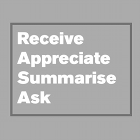 5. Receive, Appreciate, Summarize, Ask
5. Receive, Appreciate, Summarize, Ask
RASA is a powerful concept in conversations. Receive: when people talk with you, look at them (avoid using your mobile phone). Appreciate: show people that you understand them, by moving your head and by using expressions like ‘hmm’ and ‘oh, really?’. Summarize: ‘so’ is powerful and productive in business meetings. After everybody spoke, you say: ‘so, what we’re saying is this – now, let’s deal with that‘. Ask: follow-up by asking topic-relevant questions.
Become listener’s trusted guide
In Treasure’s opinion, radio should continue to deliver good content through massive coverage at low cost: “In a future where we have this tidal wave of content, radio can be a trusted guide in sound.” Emotion plays and important role as well, because even when people consume radio unconsciously, sounds communicate very directly (more about this in part 1 of this article). He ends with a couple of 6 to dos for radio people with an eye on the future:
1. Listen consciously
“Become responsible for the sound around you, and the sound you make”
2. Sound consistently
“Great brands are about consistency – consistency in sound, as well as in vision”
3. Leverage your expertise
“You understand the power of sound; you breathe it and have a head start on iTunes and Spotify”
4. Guide your audience
“The magic of radio is introducing people to things they didn’t know they were going to like”
5. Practice listening
“This is a big job in society, and radio is a curator of listening – that’s a powerful place to be”
6. Redefine radio
“Take back that word; it’s been taken away from you. Radio means relationship, not robot”
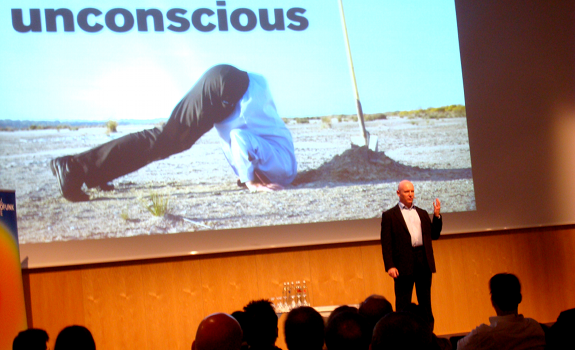
Even though people perceive sound mainly subconsciously, it affects them emotionally, Julian Treasure explains in his speech about sound, listening and the future of radio at the Lokalrundfunktage 2012 (photo: Thomas Giger)
Read also:
- Future (related articles)
- Powerful Radio Brand Sound Secrets Unveiled
Stay tuned, follow us @RadioILOVEIT and click below to share this post:





Add Your Comment